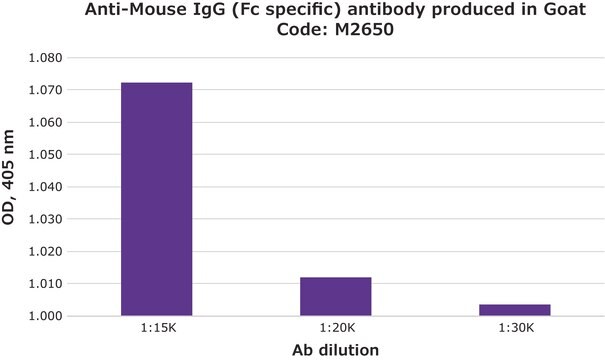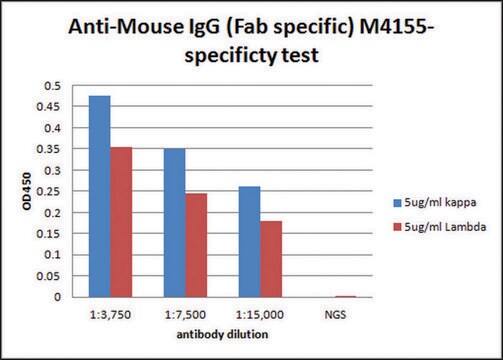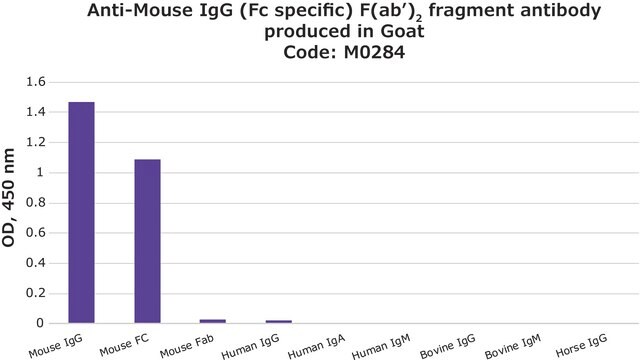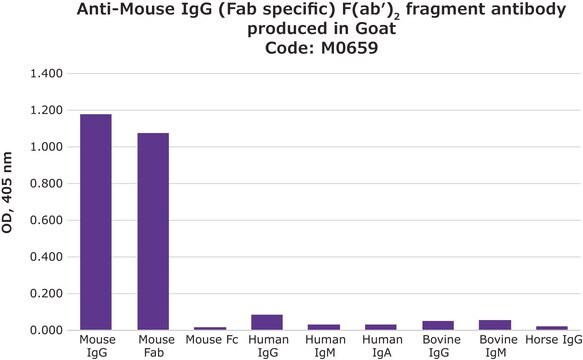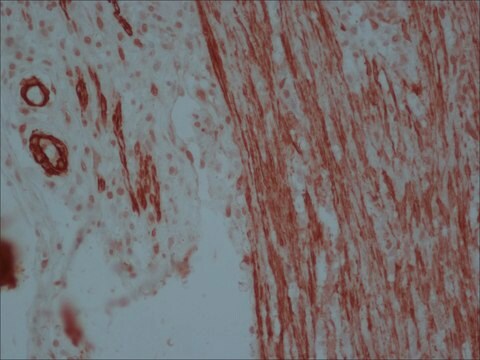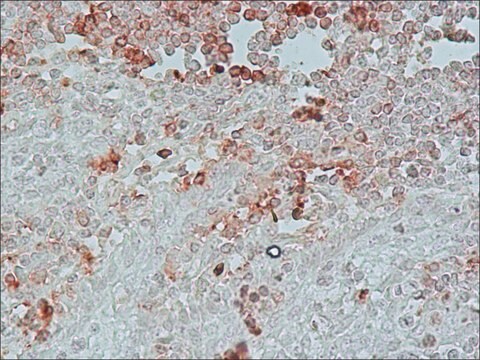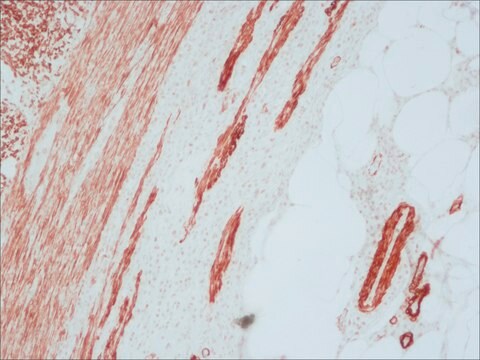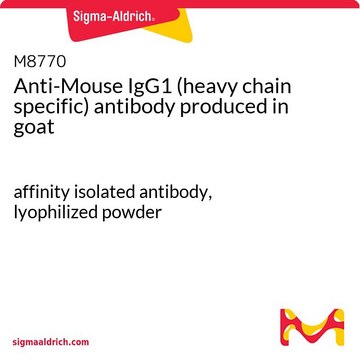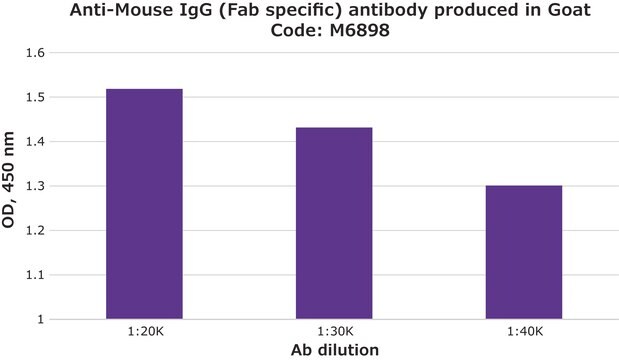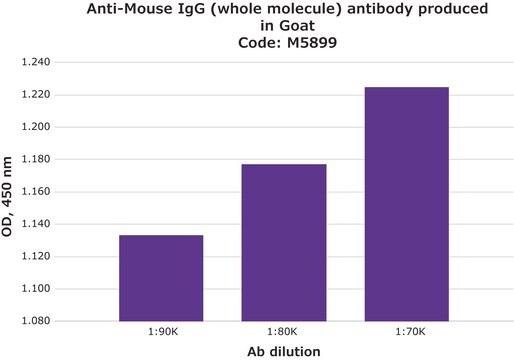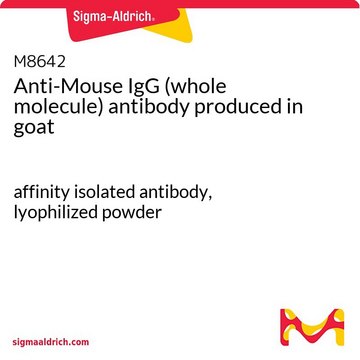Wszystkie zdjęcia(1)
Kluczowe dokumenty
M3534
Anti-Mouse IgG (Fc specific) antibody produced in goat
2.0 mg/mL, affinity isolated antibody
Zaloguj sięWyświetlanie cen organizacyjnych i kontraktowych
About This Item
Polecane produkty
pochodzenie biologiczne
goat
Poziom jakości
białko sprzężone
unconjugated
forma przeciwciała
affinity isolated antibody
rodzaj przeciwciała
secondary antibodies
klon
polyclonal
stężenie
2.0 mg/mL
metody
indirect ELISA: 1:15,000
Warunki transportu
dry ice
temp. przechowywania
−20°C
docelowa modyfikacja potranslacyjna
unmodified
Szukasz podobnych produktów? Odwiedź Przewodnik dotyczący porównywania produktów
Powiązane kategorie
Opis ogólny
IgG subtype is the most abundant serum immunoglobulins of the immune system. It is secreted by B cells and is found in blood and extracellular fluids.
Immunogen
Mouse IgG, Fc fragment
Zastosowanie
Anti-Mouse IgG (Fc specific) antibody has been used in:
- enzyme linked immunosorbent assay (ELISA)
- Ouchterlony double diffusion
- anti-drug antibody immunoassay
- immunoelectrophoresis
Działania biochem./fizjol.
Immunoglobulin G (IgG) is a glycoprotein antibody that regulates immune responses such as phagocytosis and is also involved in the development of autoimmune diseases . Mouse IgGs have four distinct isotypes, namely, IgG1, IgG2a, IgG2b, and IgG3. IgG1 regulates complement fixation in mice
Inne uwagi
Antibody adsorbed with human IgG and rat serum proteins
Postać fizyczna
Solution in 0.01 M phosphate buffered saline, pH 7.4, containing 15 mM sodium azide.
Uwaga dotycząca przygotowania
Adsorbed to reduce background with human or rat samples.
Oświadczenie o zrzeczeniu się odpowiedzialności
Unless otherwise stated in our catalog or other company documentation accompanying the product(s), our products are intended for research use only and are not to be used for any other purpose, which includes but is not limited to, unauthorized commercial uses, in vitro diagnostic uses, ex vivo or in vivo therapeutic uses or any type of consumption or application to humans or animals.
Ta strona może zawierać tekst przetłumaczony maszynowo.
Nie możesz znaleźć właściwego produktu?
Wypróbuj nasz Narzędzie selektora produktów.
Kod klasy składowania
10 - Combustible liquids
Klasa zagrożenia wodnego (WGK)
WGK 3
Temperatura zapłonu (°F)
Not applicable
Temperatura zapłonu (°C)
Not applicable
Wybierz jedną z najnowszych wersji:
Masz już ten produkt?
Dokumenty związane z niedawno zakupionymi produktami zostały zamieszczone w Bibliotece dokumentów.
Klienci oglądali również te produkty
Integrating molecular detection and response to create self-signalling antibodies
Randle B, et al.
Biochemical and Biophysical Research Communications, 324(2), 504-510 (2004)
Universal immunoassay applied during early development of large molecules to understand impact of immunogenicity on biotherapeutic exposure
Bautista AC, et al.
The APPS Journal, 14(4), 843-849 (2012)
N Ban et al.
British journal of cancer, 101(2), 363-371 (2009-06-11)
The essential aetiology of radiation-induced acute myeloid leukaemia (AML) in mice is the downregulation of the transcription factor PU.1. The causative mutation of the PU.1-endocing Sfpi1 gene consists mostly of C:G to T:A transitions at a CpG site and is
Nathan H Joh et al.
Journal of pharmaceutical sciences, 109(1), 845-853 (2019-10-20)
Silicone oil is a lubricant for prefilled syringes (PFS), a common primary container for biotherapeutics. Silicone oil particles (SiOP) shed from PFS are a concern for patients due to their potential for increased immunogenicity and therefore also of regulatory concern.
Development and validation of a standardized ELISA for the detection of soluble Fc-epsilon-RI in human serum
Lexmond W, et al.
Journal of Immunological Methods, 373(1-2), 192-199 (2011)
Nasz zespół naukowców ma doświadczenie we wszystkich obszarach badań, w tym w naukach przyrodniczych, materiałoznawstwie, syntezie chemicznej, chromatografii, analityce i wielu innych dziedzinach.
Skontaktuj się z zespołem ds. pomocy technicznej

